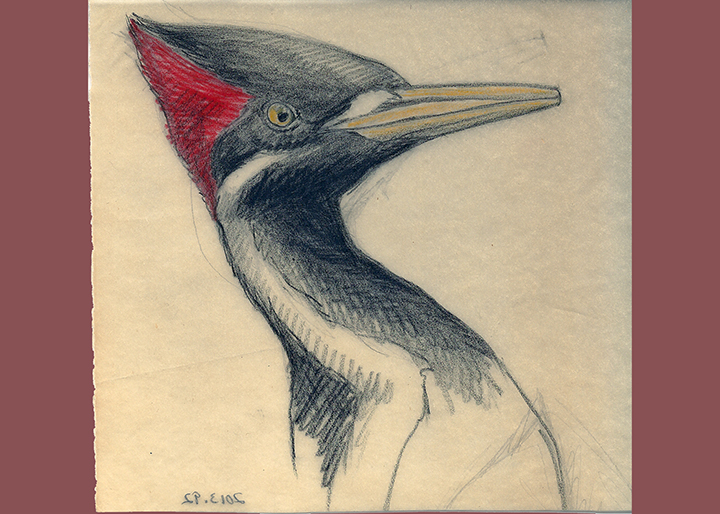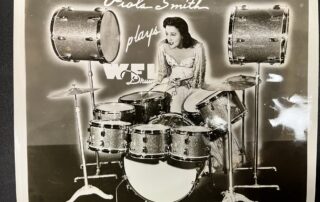Birds are dominating the spotlight at the Leigh Yawkey Woodson Art Museum this month as the acclaimed Birds in Art 2018 exhibition opens. The paintings and sculptures draw people to Wausau every year. Author BJ Hollars reflects on a time he was moved by a particular work of avian art: sketches of the Ivory-billed woodpecker. It’s a bird once thought to be lost, although it may have been sighted in Arkansas in 2005 and potentially in Cuba.
The Resurrection of the Lord God Bird
We saw her for the last time in 1944—frantic, wild-eyed, twitching about in her tree. Or rather, 23-year-old wildlife artist Don Eckelberry saw her, having traveled south to Louisiana’s Singer Tract to paint the world’s last Ivory-billed Woodpecker.
The woodpecker (known also as the “Lord God Bird” for the phrase most often uttered upon seeing one) was paying a high price for man’s destruction. We halved their habitat, felling the cypress trees to smithereens, the hollers of “Timber, timber, timber, timber” droning out the kent-calls from those birds.
And then one day “those” birds became “that” bird, and “that” bird became the only one left to sketch. The black-crested female made herself available to the man with the sketchbook down below: posed, pecked, trumpeted her fading call.
Frantic and wild-eyed himself, Eckelberry saved what part of her he could. And what he saved—sketches—I’d find myself 70 years later, in a manila folder in Wausau’s Leigh Yawkey Woodson Art Museum. I’d traveled there for the extinct bird exhibit, anxious to see paintings of Passenger Pigeons and Great Auks and representations of all the birds we’ll never see again. But I’d never expected to find Eckelberry’s last sketches of that last Ivory-bill, at least not until the curator offhandedly mentioned to me that she had them in her office.
The curator and I wound through the museum’s stairwells and corridors until arriving there. As I opened the folder and held the sketches in my hands, I could feel a bit of both artist and subject alongside me.
What must’ve it been like? I wonder. To watch a species disappear before his eyes? And what must’ve it been like to be the last of her kind, offering her call only to hear the echo call back?
As I stare at Eckelberry’s sketches, my waxing poetic turns suddenly practical. I notice that in half of the sketches, the female’s black crest is sketched red—the clear marking of a male. Which means nothing on its own; merely that Eckelberry was, perhaps, taking a bit of creative license to offer posterity a depiction of both.
Unless, I think, it means everything.
My conspiracy theory goes a little like this: Well aware of the attention he’d draw by acknowledging the existence of a breeding pair, Eckelberry remained mum, instead: reported only the female, thereby protecting the privacy of the world’s last chance for an egg. And maybe, deep in the hole in the roosting tree there was an egg, or two eggs, or enough eggs to keep our Lord God Bird alive awhile longer. Perhaps he kept his truth hidden in his sketches, until a decade or so after his death, when some poor fool who wanted too much to believe in the bird’s resurrection suddenly found some new reason to do so.
Of course! I think, staring at the red crest aflame in the sketches stretched before me.
But…of course not, also.
In a nearby file, I find one of Eckelberry’s unpublished poems.
Another clue, I think.
“Mostly we are preserved,” Eckelberry wrote, “in life beyond our time / Glazed, pickled, set in amber / and casketed above the ground.”
…casketed above the ground…
What if, I think, her echo wasn’t an echo after all, but a ‘Hello, sweetheart, welcome home.’
==
Song: “Tell” by Alaskan Tapes and Voga
Ivory-billed woodpecker recordings were made by Arthur A. Allen and Peter Paul Kellogg in Madison, Louisiana in April 1935. Courtesy of the Macaulay Library at the Cornell Lab of Ornithology











